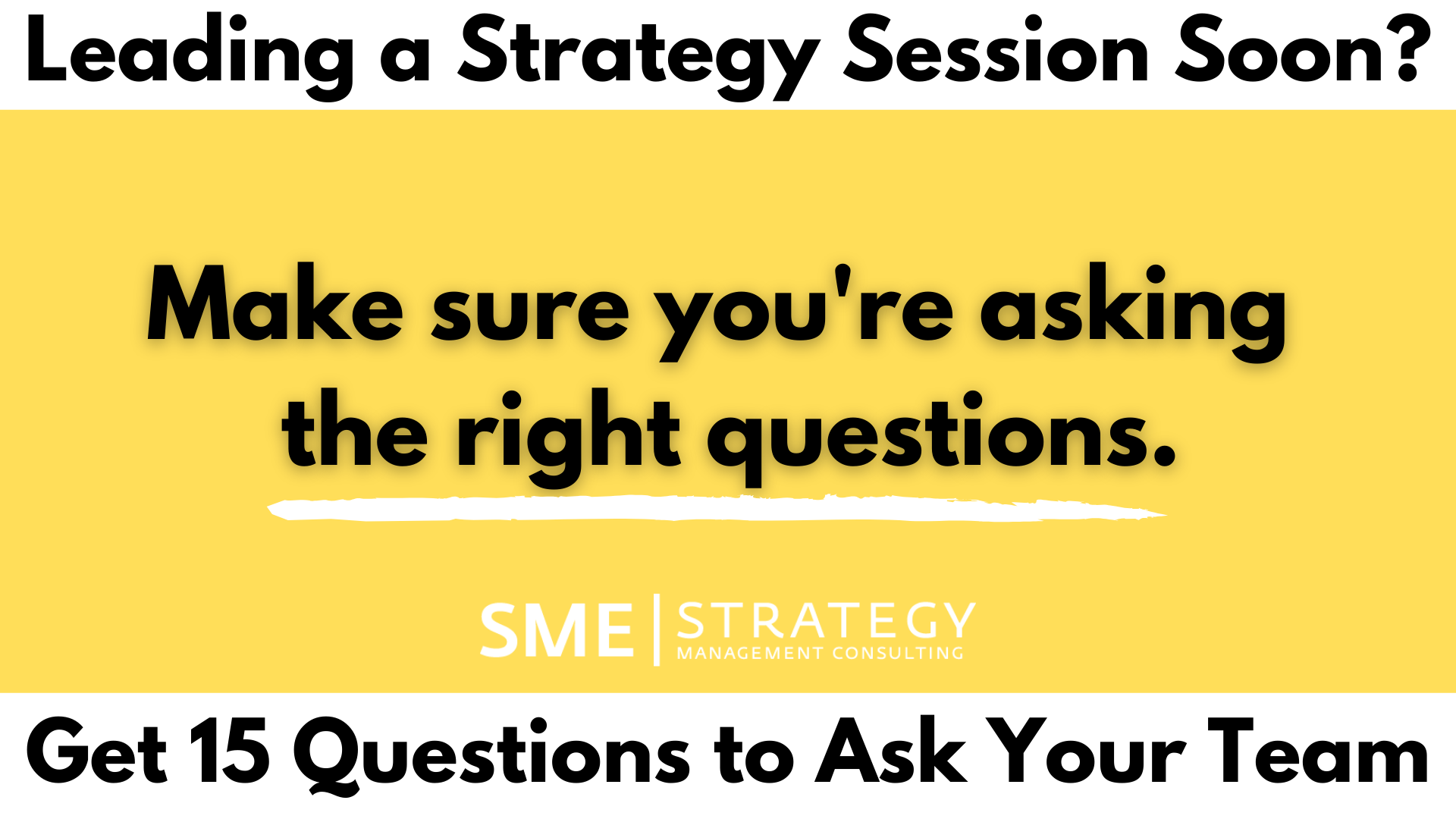How To Execute A Strategy Plan (2 Things You Need to know To Avoid a Shelf Plan).

SME Strategy is a strategy consulting firm that specializes in helping organizations align their teams and operations around a shared vision, mission, values, goals, and action plans. Our strategic planning services offer guidance on how a strategic planning facilitator can provide support in constructing an effective strategic plan that ensures your strategy is communicated and implemented across your entire organization.
In this blog, we want to share with you two things that we think are critical for you to execute your strategic plan, and not have it be a shelf plan.
Research shows that a significant percentage of strategic plans, ranging from 60% to 90%, fail to achieve full implementation.
Why?
A common issue we often encounter when reviewing old strategic plans for organizations is the lack of follow-through and utilization after the strategic planning process. Despite investing significant resources and effort into creating a strategic plan, many organizations fail to revisit it and implement the necessary actions to achieve their goals."
Unfortunately, when strategic plans are not reviewed and progress is not made towards their implementation, they can become known as 'shelf plans,' gathering dust and becoming obsolete. This term highlights a significant issue faced by many organizations: the failure to put strategic plans into action."
This leaves a huge gap and confusion among leadership teams: How do we execute our strategy plan, and avoid a shelf plan?
Remember:
Strategic planning is an ongoing process that requires continued effort beyond the initial offsite. Regardless of the size or type of organization, effective implementation of the strategic plan is crucial. This requires a significant investment of resources, including time and training, in addition to financial costs. Unfortunately, many organizations struggle to execute their strategic plans despite engaging external strategic planning facilitators to guide the process."
To ensure the successful implementation of the strategic plan, organizations should focus on two key factors:
1. Accountability
Establishing a culture of accountability is vital to the successful execution of a strategic plan or complex project. To achieve this, it is crucial that everyone in your organization understands the mission and vision of the strategy, as well as their individual roles and responsibilities in its implementation. Accountability is not limited to frontline employees but extends to managers and leaders at all levels, who must honor their commitments and fulfill their obligations.
Without a culture of accountability, projects are at risk of delays or derailment, and negative attitudes such as indifference and poor performance can develop, which can lead to a lack of trust and have a detrimental effect on overall performance and culture.
How to execute a strategy plan by developing accountability:
Motivating your team by involving them in the development of their own strategic accountabilities is more effective than delegating tasks and micromanaging. By working together to set clear and actionable targets, team members can take ownership of their responsibilities and agree upon reasonable goals, rather than having them imposed upon them.
This approach promotes a sense of ownership and engagement in the organization's strategy, which increases motivation and productivity. It also helps to ensure that everyone is working towards the same goals and objectives, which fosters a sense of teamwork and shared ownership.
To implement this approach, managers should encourage team members to take an active role in developing their own accountabilities, provide support and guidance as needed, and regularly review progress and adjust goals as necessary. This approach empowers your team members to take ownership of their work and provides a sense of autonomy and control over their own success.
What does actionable accountability look like?
Establishing a clear and actionable plan is crucial to ensuring that all decisions made inside your organization are in line with your vision and strategic priorities.
1. Identifying your vision and strategic priorities is the first step in developing a plan that is clear and actionable. Ensure that they are specific, measurable, achievable, relevant, and time-bound (SMART). This will provide a clear framework for decision-making and goal-setting.
2. Identify the key objectives and goals that need to be accomplished to achieve your vision and strategic priorities. Break these down into smaller, actionable steps that can be assigned to specific individuals or teams within the organization.
3. Connect your strategic plan to your operations, You can keep up the momentum and make sure that your efforts are in line with your overall objectives by smoothly integrating your strategy into your operations.
This is crucial because unforeseen events may occur and force your team to change their priorities while carrying out your strategic plan. You may more readily adjust to changing conditions while still remaining in sync with your vision and strategic priorities
4. Regularly communicate progress and celebrate successes to maintain momentum and engagement.
Check out this blog To read more about How to Improve Accountability When Implementing Your Strategic Plan.
We can help you align your team around a clear vision, mission, values, goals and action plans,
so you can lead your organization more effectively and get better results.
2. Development:
While creating a strategic plan may seem like a straightforward task, it is important to recognize that it represents the difference between the current state of your organization and where it aims to be in the future. As your team goes through the strategic planning process, it is essential to approach it with a clear understanding of your organization's current position and the challenges and opportunities that lie ahead.
Remember: Your people are the driving force behind executing actions, and the success of your strategic plan is ultimately dependent on their ability to execute it. Regardless of the quality of your initial strategic plan or the investment in a strategy facilitator, it is up to your team to take ownership and accountability for implementing the plan.
To achieve this, it is important to ensure that everyone on your team is fully committed to the strategic vision. This requires effective communication, engagement, and collaboration, to build a shared understanding of the goals, objectives, and action items that are necessary to achieve success.
You also need a High functioning team that doesn't just work collaboratively with each other, but that all have sufficient capacity and training in the critical capacities for strategy execution in order for them to reach their goals.
As a leader, ensuring your team acquires the necessary skills WITHIN the context of your strategic plan will help them be better equipped to fulfill their role in driving the organization forward.
Example :
You run a multinational with various products, and one of your strategic goals is to drive revenue for a particular product line while limiting the loss of market share to no more than 5% on its other products. To achieve this, it is important that your team has sufficient training on setting strategic priorities to ensure that the most important initiatives are carried out without neglecting other tasks.
To illustrate the importance of prioritization, consider the following scenario: if your company has a total of $1,000,000 in revenue and you aim to increase revenue for a particular product line by 10%, or $100,000 while maintaining no more than a 5% loss in revenue from your other products, you can allocate a maximum of $50,000 towards the other product lines.
This means that your team must prioritize the initiatives that will generate the greatest return on investment for the targeted product line while balancing the resources available for the other products. With proper training in prioritization, your team can ensure that the most important initiatives are carried out while avoiding neglecting other tasks and risking a loss in market share.
How Management Training programs help execute your strategy plan:
Incorporating management training into your strategy process can significantly enhance the team's capabilities and boost overall performance. We recommended developing an actionable plan that can be executed regularly, such as quarterly management training workshops, to promote the acquisition of new skills and capacities.
To achieve this, consider identifying areas of improvement that are aligned with your strategic goals and focus on developing skills and capacities that support them. This could involve offering management training programs, workshops, or mentorship opportunities, which would enable team members to acquire new skills or improve upon existing ones. By investing in their professional development, your team members will feel valued and motivated to contribute to the success of the team.
Additionally, it is important to facilitate regular discussions that allow team members to share their insights and perspectives on how to work better together. This can help to identify potential issues and opportunities for improvement, leading to more effective collaboration and higher-quality outcomes.
By integrating management training programs into your strategy process, you can create a culture of continuous improvement, where the team is encouraged to grow and develop collectively. This not only promotes a sense of unity and common purpose, but it also leads to greater leadership skills, better chances of successfully executing strategies, and overall better organizational performance.




